Visión general
A box plate roll forming machine is a specialized equipment used to produce box-shaped components or structural elements from flat metal sheets or coils. These machines are widely employed in various industries, including construction, automotive, aerospace, and manufacturing, due to their ability to create sturdy and precise box structures efficiently.
The roll forming process involves feeding a flat metal strip through a series of roller stations, gradually bending and shaping the material into the desired box profile. The resulting box sections can be customized in terms of dimensions, material thickness, and cross-sectional shape, making them versatile for a wide range of applications.
Understanding the Box Plate Roll Forming Process
The box plate roll forming process begins with a coil of flat metal, typically steel, aluminum, or other alloys. The coil is fed into the machine’s decoiler, which unwinds the material at a controlled pace. The metal strip then enters the roll forming mill, where it passes through a sequence of precisely designed roller stations.
Each roller station consists of a set of top and bottom rollers that gradually bend and shape the metal strip into the desired box profile. The rollers are strategically positioned and configured to ensure precise and consistent forming of the box section. As the strip progresses through the roller stations, the cross-sectional shape is gradually transformed until the final box profile is achieved.
After the roll forming process, the continuous box section can be further processed, such as cutting to length, punching, or welding, depending on the specific application requirements.
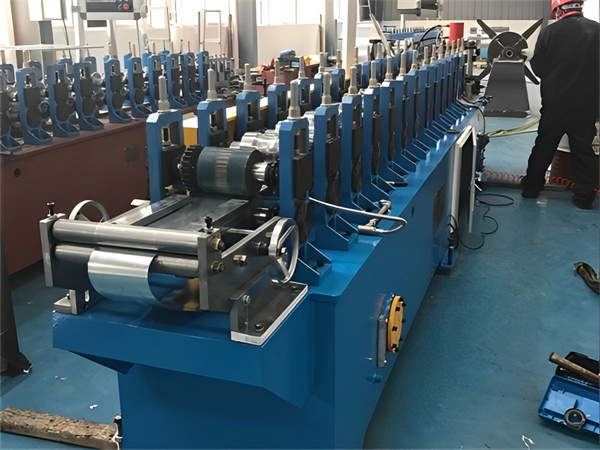
Types of Box Plate Roll Forming Machines
| Tipo de máquina | Descripción |
|---|---|
| Entry-Level Box Plate Roll Forming Machines | These machines are designed for light-duty applications and are suitable for smaller production runs or prototyping. They typically have fewer roller stations and may offer limited customization options. |
| Industrial Box Plate Roll Forming Machines | Intended for high-volume production, these robust machines feature a larger number of roller stations and can accommodate a wide range of materials and thicknesses. They offer greater flexibility in terms of box profile customization and production speed. |
| Portable Box Plate Roll Forming Machines | Designed for on-site or mobile applications, these compact machines are easy to transport and set up. They are often used in construction sites or remote locations where box sections need to be produced on-demand. |
| Computerized Box Plate Roll Forming Machines | These advanced machines incorporate computer numerical control (CNC) systems, allowing for precise and automated control of the roll forming process. They offer enhanced accuracy, repeatability, and the ability to produce complex box profiles with ease. |
Material Feeding and Forming Capabilities
| Material | Descripción |
|---|---|
| Acero | Various grades of steel, including mild steel, stainless steel, and high-strength steel, can be processed using box plate roll forming machines. Steel is a popular choice for its strength and durability. |
| Aluminio | Aluminum alloys are commonly used in applications where lightweight and corrosion resistance are essential, such as in the aerospace and automotive industries. |
| Cobre | Copper and its alloys can be roll formed into box sections for applications in electrical and plumbing industries. |
| Acero galvanizado | Galvanized steel, which is coated with a protective zinc layer, offers enhanced corrosion resistance and is suitable for outdoor or harsh environments. |
Box plate roll forming machines can accommodate a wide range of material thicknesses, typically ranging from 0.5 mm to 6 mm or even thicker, depending on the machine’s capabilities and the specific application requirements.
Design and Customization Options
One of the key advantages of box plate roll forming machines is their ability to produce box sections with customized dimensions and cross-sectional shapes. This versatility allows manufacturers to meet specific project requirements or create unique designs tailored to their needs.
Common customization options include:
- Box section dimensions (width, height, and wall thickness)
- Cross-sectional shapes (square, rectangular, trapezoidal, or custom profiles)
- Inclusion of additional features (holes, notches, or embossments)
- Integration of reinforcement elements (stiffeners or internal braces)
Advanced roll forming machines often incorporate computer-aided design (CAD) software, enabling users to design and visualize their desired box profiles prior to production.
-
 Máquina perfiladora de tubos de soldadura
Máquina perfiladora de tubos de soldadura -
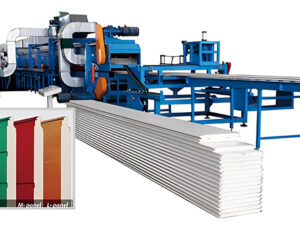 Máquina perfiladora de panel de puerta de garaje
Máquina perfiladora de panel de puerta de garaje -
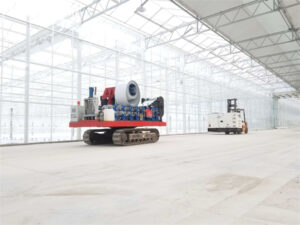 Máquina formadora de rollos de panel de canal de agricultura moderna verde con cadena de tanque
Máquina formadora de rollos de panel de canal de agricultura moderna verde con cadena de tanque -
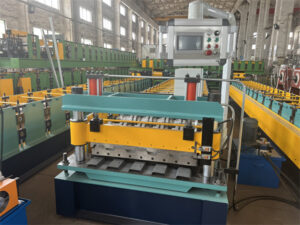 Máquina formadora de rollos China para panel de cerca PPGI automáticamente
Máquina formadora de rollos China para panel de cerca PPGI automáticamente -
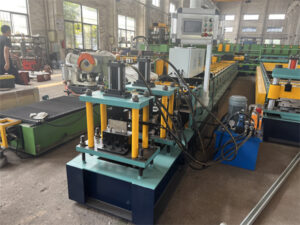 Compañía de máquinas formadoras de rollos para riel de guía de cerca
Compañía de máquinas formadoras de rollos para riel de guía de cerca -
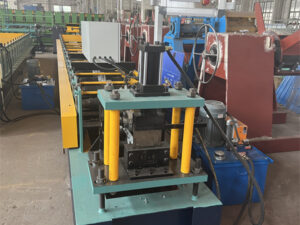 Costo de la máquina formadora de rollos para riel de guía de poste de cerca a buen precio
Costo de la máquina formadora de rollos para riel de guía de poste de cerca a buen precio -
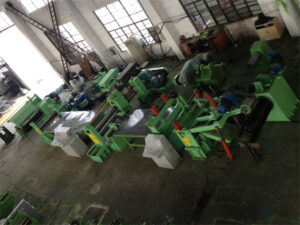 Línea de corte longitudinal
Línea de corte longitudinal -
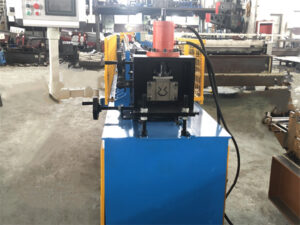 Máquina perfiladora de puntales en V
Máquina perfiladora de puntales en V -
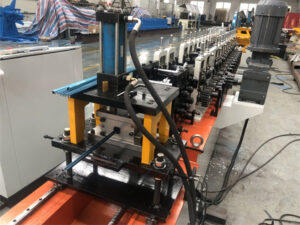 Canal U inoxidable para máquina de soporte de ventana de vidrio
Canal U inoxidable para máquina de soporte de ventana de vidrio
Material Slicing and Edge Conditioning
In addition to roll forming, many box plate machines offer integrated material slicing and edge conditioning capabilities. These features enhance the overall quality and usability of the produced box sections.
Material slicing involves cutting the continuous box section into individual lengths using either shear cutters or saws, depending on the machine’s configuration and the required precision.
Edge conditioning processes, such as deburring or edge trimming, ensure that the cut edges of the box sections are smooth and free from burrs or sharp edges, improving safety and facilitating further processing or installation.
Industrial Applications of Box Plate Roll Forming Machines
Box plate roll forming machines find applications across various industries due to the versatility and strength of the produced box sections. Some common applications include:
| Industria | Aplicaciones |
|---|---|
| Construcción | Structural components for buildings, bridges, and infrastructure projects |
| Automoción | Automotive frames, chassis components, and body reinforcements |
| Aeroespacial | Aircraft structural elements, wing spars, and fuselage components |
| Fabricación | Material handling equipment, racking systems, and industrial furniture |
| Energías renovables | Support structures for wind turbines and solar panel mounting systems |
Choosing a Reliable Box Plate Roll Forming Machine Supplier
When selecting a box plate roll forming machine supplier, it is crucial to consider several factors to ensure a reliable and long-lasting investment. Here are some key considerations:
| Factor | Descripción |
|---|---|
| Reputación y experiencia | Choose a supplier with a proven track record and extensive experience in the roll forming industry. Reputable suppliers typically offer high-quality machines and reliable customer support. |
| Machine Capabilities | Evaluate the machine’s capabilities in terms of material compatibility, thickness range, production speed, and customization options to ensure it meets your specific requirements. |
| Quality and Precision | Assess the supplier’s commitment to quality and precision engineering. High-quality machines with precise roller alignment and robust construction will produce consistent and accurate box profiles. |
| Servicio y asistencia | Consider the supplier’s after-sales service and support offerings, such as technical assistance, spare parts availability, and maintenance services. This can ensure efficient operation and minimize downtime. |
| Customization and Integration | If you have specific requirements or need to integrate the machine into an existing production line, look for suppliers that offer customization and integration services. |
| Price and Value | While cost is an important consideration, it should be balanced against the machine’s quality, capabilities, and overall value proposition. Reputable suppliers often provide competitive pricing and long-term cost savings through efficient and reliable operation. |
Instalación, funcionamiento y mantenimiento
Proper installation, operation, and maintenance are essential for maximizing the performance and lifespan of a box plate roll forming machine. Here are some key considerations:
| Factor | Descripción |
|---|---|
| Instalación | Engage the supplier or qualified professionals for proper machine installation, leveling, and alignment to ensure optimal performance and prevent premature wear or damage. |
| Capacitación de los operadores | Ensure that machine operators receive comprehensive training on proper operation, safety protocols, and maintenance procedures from the supplier or qualified trainers. |
| Mantenimiento preventivo | Implement a regular preventive maintenance schedule, including inspections, lubrication, and component replacements as recommended by the manufacturer. This can help prevent breakdowns and extend the machine’s lifespan. |
| Recambios y consumibles | Maintain an adequate supply of spare parts and consumables, such as roller bearings, belts, and cutting tools, to minimize downtime in case of replacements or repairs. |
| Calibrado y alineación | Regularly calibrate and align the roller stations to maintain precision and accuracy in the roll forming process, ensuring consistent product quality. |

Pros and Cons of Box Plate Roll Forming Machines
Like any manufacturing equipment, box plate roll forming machines have their advantages and limitations. Understanding these factors can help in making an informed decision and optimizing their use.
Ventajas
- Alta eficiencia de producción: Roll forming machines can produce continuous box sections at high speeds, resulting in increased productivity and cost-effectiveness.
- Ahorro de material: By utilizing flat metal coils or sheets as the starting material, roll forming minimizes material waste compared to other manufacturing processes.
- Versatilidad: These machines can produce a wide range of box profiles with customized dimensions and cross-sectional shapes, catering to diverse application requirements.
- Calidad constante: With precise roller alignment and computer control, roll forming machines can consistently produce box sections with high dimensional accuracy and repeatability.
- Strength and Durability: Roll-formed box sections are known for their structural integrity and durability, making them suitable for load-bearing applications.
Limitaciones
- Inversión inicial: High-quality box plate roll forming machines can be a significant capital investment, especially for advanced models with extensive customization capabilities.
- Limitaciones materiales: While versatile, roll forming machines are typically limited to specific material types and thickness ranges, depending on their design and capabilities.
- Tiempo de preparación y cambio: Changing from one box profile to another may require roller adjustments or replacements, resulting in downtime and reduced production efficiency.
- Skill Requirements: Proper operation and maintenance of roll forming machines require skilled and well-trained personnel to ensure optimal performance and product quality.
- Size Constraints: Roll forming machines have limitations in terms of the maximum dimensions and complexity of the box profiles they can produce, which may restrict their applications in certain industries or projects.
Factors to Consider When Choosing a Box Plate Roll Forming Machine
When selecting a box plate roll forming machine, it is essential to consider various factors to ensure that the machine meets your specific requirements and provides optimal performance. Here are some key considerations:
| Factor | Descripción |
|---|---|
| Volumen de producción | Assess your production volume requirements and choose a machine with the appropriate capacity and speed to meet your desired output. |
| Requisitos materiales | Consider the types of materials you need to process (e.g., steel, aluminum, or other alloys) and their thickness ranges to ensure compatibility with the machine’s capabilities. |
| Box Profile Requirements | Evaluate your desired box profile dimensions, cross-sectional shapes, and any additional features (e.g., holes, notches, or reinforcements) to ensure the machine can accommodate your specifications. |
| Personalización y flexibilidad | Determine the level of customization and flexibility you require in terms of profile design, material compatibility, and production flexibility. Consider machines with computer control and CAD integration if you anticipate frequent design changes or complex profiles. |
| Automatización e integración | If you plan to integrate the roll forming machine into an automated production line or existing system, consider machines with compatible controls and interfaces for seamless integration. |
| Espacio y distribución | Ensure that the machine’s footprint and layout fit within your available floor space and production facility, considering any necessary clearances and access for maintenance and material handling. |
| Energy Efficiency and Environmental Impact | Evaluate the machine’s energy consumption and environmental footprint, as well as any necessary safety and emission control measures, to align with your sustainability goals and regulatory requirements. |
| Servicio y asistencia | Consider the supplier’s reputation, service and support offerings, spare parts availability, and training programs to ensure reliable operation and minimize downtime. |
| Presupuesto y rendimiento de la inversión | While cost is a significant factor, it’s essential to balance it with the machine’s capabilities, quality, and long-term return on investment (ROI) through efficient and reliable operation. |
By carefully considering these factors and consulting with experienced suppliers and industry experts, you can make an informed decision and select a box plate roll forming machine that meets your specific needs and delivers optimal performance and value for your business.

preguntas frecuentes
Q: What is a box plate roll forming machine? A: A box plate roll forming machine is specialized equipment used to produce box-shaped structural components or sections from flat metal sheets or coils. It involves feeding the metal through a series of roller stations that gradually bend and shape the material into the desired box profile.
Q: What materials can be used in box plate roll forming? A: Common materials used in box plate roll forming include steel (mild steel, stainless steel, high-strength steel), aluminum alloys, copper, and galvanized steel. The machine’s capabilities will determine the specific material types and thickness ranges that can be processed.
Q: Can box plate roll forming machines produce custom box profiles? A: Yes, one of the key advantages of box plate roll forming machines is their ability to produce customized box profiles in terms of dimensions, cross-sectional shapes, and additional features like holes, notches, or reinforcements. Advanced machines often incorporate computer-aided design (CAD) software for profile customization.
Q: How do I choose the right box plate roll forming machine for my needs? A: Selecting the right machine involves considering factors such as production volume requirements, material types and thicknesses, desired box profile specifications, customization and flexibility needs, automation and integration requirements, floor space constraints, energy efficiency, service and support offerings, and budget and return on investment.
Q: What are the advantages of using a box plate roll forming machine? A: Some key advantages include high production efficiency, material savings, versatility in profile customization, consistent quality and dimensional accuracy, structural strength and durability of the produced box sections, and the ability to integrate into automated production lines.
Q: Are there any limitations to box plate roll forming machines? A: While highly versatile, box plate roll forming machines may have limitations in terms of initial investment costs, compatible material types and thickness ranges, setup and changeover times, skill requirements for operation and maintenance, and size constraints for the maximum dimensions and complexity of box profiles.
Q: How do I ensure proper installation, operation, and maintenance of a box plate roll forming machine? A: Engage the supplier or qualified professionals for proper installation, leveling, and alignment. Provide comprehensive operator training, implement regular preventive maintenance schedules, maintain spare parts and consumables, and perform periodic calibration and alignment to ensure optimal performance and longevity of the machine.
